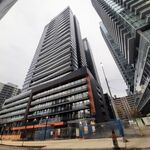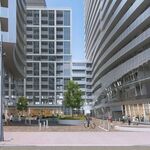kEiThZ
Superstar
Why should the rail yard move?
To make way for badly needed housing inside the 416. And to get an opportunity to build a yard that better suits their current operations.
Why should the rail yard move?
That is about the only reason that would make sense.However, the cleanup of that area would be an astronomical cost that it may make the area unaffordable.To make way for badly needed housing inside the 416. And to get an opportunity to build a yard that better suits their current operations.
Why has no one suggested redeveloping this as industrial/employment land? Of course if the bar is for residential intensification, then this is a non-starter. But the requirements and interest for new industrial in Toronto are much different. See Steelport; reusing industrial land doesn’t have to mean condos- sometimes being stuck on that neglects the possibilities that are even better for the city- especially if you don’t have to remediate as much.Agreed. There are much better redevelopment candidates in Toronto than this yard. There are failing malls, boarded-up homes and businesses and empty parking lots in Toronto right now, most of which are better served by existing transit and are closer to the downtown core than an active railyard that serves a current purpose and would need to be replaced 1 for 1 or bigger if removed.
Agreed. There are much better redevelopment candidates in Toronto than this yard. There are failing malls, boarded-up homes and businesses and empty parking lots in Toronto right now, most of which are better served by existing transit and are closer to the downtown core than an active railyard that serves a current purpose and would need to be replaced 1 for 1 or bigger if removed.
What kind of industry is begging for large plots of expensive land?Why has no one suggested redeveloping this as industrial/employment land? Of course if the bar is for residential intensification, then this is a non-starter. But the requirements and interest for new industrial in Toronto are much different. See Steelport; reusing industrial land doesn’t have to mean condos- sometimes being stuck on that neglects the possibilities that are even better for the city- especially if you don’t have to remediate as much.
Generally moving CP is a good idea, but I think it can only be a part of getting them off the midtown line (ie, missing link). If you move the yard but they still use the line, I don’t know how or why you’d serve a community here with (good) transit anyhow.
I’ll admit I don’t know. But the conversation of redevelopment in the medium term only moves into viability if you can avoid the costs of full remediation. In fact I think developers too would prefer the lower-cost, potentially higher return option, even if the demand for it will need some time to mount. You’ll still have rail access, so I imagine logistics/distribution/warehousing would find it appealing in the long term.What kind of industry is begging for large plots of expensive land?
The only way is if the development was akin to what happened in the port lands.I’ll admit I don’t know. But the conversation of redevelopment in the medium term only moves into viability if you can avoid the costs of full remediation. In fact I think developers too would prefer the lower-cost, potentially higher return option, even if the demand for it will need some time to mount. You’ll still have rail access, so I imagine logistics/distribution/warehousing would find it appealing in the long term.
Maybe the gross value is higher for residential overall, but your not gonna capture a lot of it with a significantly larger sunk cost in remediation. Not to mention that this is an area that most people already don’t really desire to live in anyhow. I think the city would agree, especially considering how they value their limited employment lands.
The issue is that the cost of the old land, plus the cost of building the new yard and other infrastructure for it needs to be recovered in the sale of the old land. I just don't see that land as being that valuable.The Agincourt site could always be a mix of commercial/industrial and residential. Determine the locations that need the most remediation, and remediate them to a standard whereby commercial could be placed on the site. The locations that need less remediation could go as residential.
Also, as was mentioned by crs1026, this is a far newer yard site that many others across the GTHA, including the lands west of Union Station, which I'm sure required far more remediation than this site would, given that there would have been almost 100 years more pollution in the ground there, including from an era when environmental regulations were non-existent.
Personally, I see this as a win-win. CP gets to sell off their existing yard location for presumably a massive profit, and gets a piece of land for what would likely be a sweetheart deal on which they can build a new, modern yard with a layout that meets their current requirements. They also get a location with easy highway access (even if it is tolled, they'd also be pretty close to the 412, which isn't). And if the GA/Freight airport ever comes to fruition, easy intermodal access. The City would get a large plot of land that could be master planned to include a cut-and-cover subway extension into the lands.
Yes this is very much a pipe dream, and nobody is seriously talking about it right now. But to me at least, the planning rationale lines up.
With a one-stop subway extension, I think it definitely can be. I can't think of another outer 416 property (with the exception of Downsview) that has as much master plan-scale redevelopment potential as the Agincourt Yard. Also, I think it would be in the government's interests to basically give CP the land they require within the Pickering Lands. CP could then use the sale of the Agincourt Yard to finance the new yard (with likely a whole lot left over), and the City of Toronto would get significantly more tax revenue from the new development there than they get from the yard.The issue is that the cost of the old land, plus the cost of building the new yard and other infrastructure for it needs to be recovered in the sale of the old land. I just don't see that land as being that valuable.
The remediation of the rail lands would be much worse than an airport.With a one-stop subway extension, I think it definitely can be. I can't think of another outer 416 property (with the exception of Downsview) that has as much master plan-scale redevelopment potential as the Agincourt Yard. Also, I think it would be in the government's interests to basically give CP the land they require within the Pickering Lands. CP could then use the sale of the Agincourt Yard to finance the new yard (with likely a whole lot left over), and the City of Toronto would get significantly more tax revenue from the new development there than they get from the yard.
Yes, the loss of farm land is regrettable, but I would much rather see a portion of the Pickering lands be used for a modified reason for why they was set aside in the first place: transportation.




